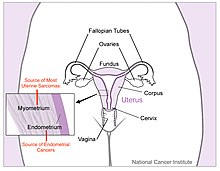| Uterine cancer | |
|---|---|
| Other names | Womb cancer |
 | |
| Diagram of uterus with labeled origins of cancer types. | |
| Specialty | Gynecology, oncology |
| Symptoms | Endometrial cancer: vaginal bleeding, pelvic pain[1] Uterine sarcoma: vaginal bleeding, mass in the vagina[2] |
| Types | Endometrial cancer, uterine sarcoma[3] |
| Risk factors | Endometrial cancer: obesity, metabolic syndrome, type 2 diabetes, tamoxifen use, unopposed estrogens, late menopause, family history of the condition[1] Uterine sarcoma: radiation therapy to the pelvis[2] |
| Treatment | Surgery, radiation therapy, chemotherapy, hormone therapy, targeted therapy[1][2] |
| Frequency | 3.8 million (2015)[4] |
| Deaths | 90,000 (2015)[5] |
Uterine cancer, also known as womb cancer, includes two types of cancer that develop from the tissues of the uterus.[3] Endometrial cancer forms from the lining of the uterus, and uterine sarcoma forms from the muscles or support tissue of the uterus.[1][2] Endometrial cancer accounts for approximately 90% of all uterine cancers in the United States.[6] Symptoms of endometrial cancer include changes in vaginal bleeding or pain in the pelvis.[1] Symptoms of uterine sarcoma include unusual vaginal bleeding or a mass in the vagina.[2]
Risk factors for endometrial cancer include obesity, metabolic syndrome, type 2 diabetes, taking pills that contain estrogen without progesterone, a history of tamoxifen use, late menopause, and a family history of the condition.[7][1] Risk factors for uterine sarcoma include prior radiation therapy to the pelvis.[2] Diagnosis of endometrial cancer is typically based on an endometrial biopsy.[1] A diagnosis of uterine sarcoma may be suspected based on symptoms, a pelvic exam, and medical imaging.[2]
Endometrial cancer can often be cured while uterine sarcoma typically is harder to treat.[3] Treatment may include a combination of surgery, radiation therapy, chemotherapy, hormone therapy, and targeted therapy.[1][2] Just over 80% of women survive more than 5 years following diagnosis.[8]
In 2015 about 3.8 million women were affected globally and it resulted in 90,000 deaths.[4][5] Endometrial cancer is relatively common while uterine sarcomas are rare.[3] In the United States, uterine cancers represent 3.5% of new cancer cases.[8] They most commonly occur in women between the ages of 45 and 74 with a median age of diagnosis of 63.[8]
- ^ a b c d e f g h "Endometrial Cancer Treatment". National Cancer Institute. 26 April 2018. Retrieved 3 February 2019.
- ^ a b c d e f g h "Uterine Sarcoma Treatment". National Cancer Institute. 3 October 2018. Retrieved 3 February 2019.
- ^ a b c d "Uterine Cancer". National Cancer Institute. 1 January 1980. Retrieved 3 February 2019.
- ^ a b "Global, regional, and national incidence, prevalence, and years lived with disability for 310 diseases and injuries, 1990-2015: a systematic analysis for the Global Burden of Disease Study 2015". Lancet. 388 (10053): 1545–1602. October 2016. doi:10.1016/S0140-6736(16)31678-6. PMC 5055577. PMID 27733282.
- ^ a b "Global, regional, and national life expectancy, all-cause mortality, and cause-specific mortality for 249 causes of death, 1980-2015: a systematic analysis for the Global Burden of Disease Study 2015". Lancet. 388 (10053): 1459–1544. October 2016. doi:10.1016/S0140-6736(16)31012-1. PMC 5388903. PMID 27733281.
- ^ Felix AS, Brinton LA (September 2018). "Cancer Progress and Priorities: Uterine Cancer". Cancer Epidemiology, Biomarkers & Prevention. 27 (9): 985–994. doi:10.1158/1055-9965.EPI-18-0264. PMC 6504985. PMID 30181320.
- ^ "Endometrial Cancer Risk Factors". www.cancer.org. Retrieved 2021-09-13.
- ^ a b c "Uterine Cancer - Cancer Stat Facts". SEER. Retrieved 3 February 2019.